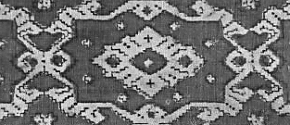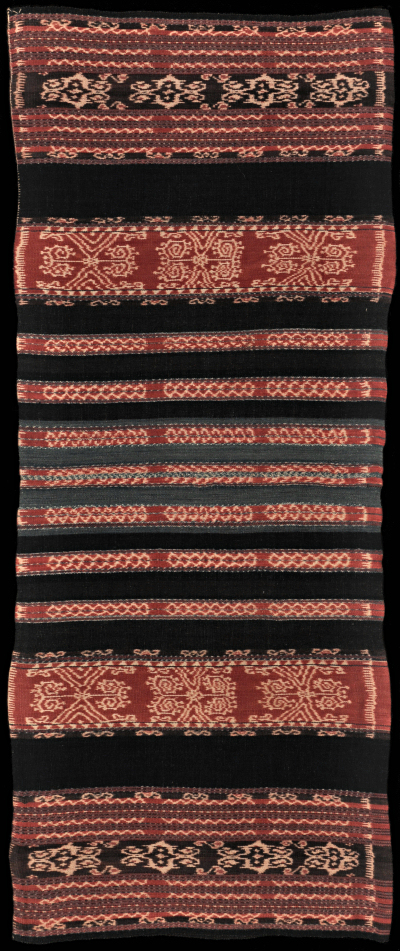| |
136 Savu Group, Savu
Ei (sarong) 
|
| Locale: | Hubi Iki - or Christian weaver. |
| Period: | 1930-1945 |
| Yarn: | Cotton, hand-spun, medium |
| Technique: | Warp ikat |
| Panels: | 2 |
| Size: | 60 x 143 cm (1' 11" x 4' 8") LW: 2.38 |
| Weight: | 520 g (18.3 oz), 303 g/m2 (0.99 oz/ft2) |
| Design: | Ei ledo for Hubi Iki. Main motif - in triple repeats as prescribed by tradition - is derived from ei ledo motif, with lane end motifs. Executed in light and dark indigo, red and purple. Originally this design was an earmark of wini Waratada, Hubi Iki. Later Christian women took the freedom to use this combination of motifs. The sarong is marked with a little zigzag in white thread at the top left corner, bunga wurumada, signaling completion of the ceremony required after the weaving and before sewing the cloth into a sarong. The unusual motif in the second widest ikated band is very similar to that seen on PC 176, and is likely to have been inspired by the same rare type of basta, Indian trade cloth. |
| Comment: | Better than average example. Warm tonality, excellent weaving shown in the complex and tightly executed patterns. There is little apparent patola influence on Savu. Should the motif indeed have been inspired by patola, than the cloth is likely to have been made by a weaver with access to one. i.e. a high class lady. Another possibility is that the motif entered Savu through a gift from the royal house of Biboki, but that seems more far-fetched than the presence on the island of the same rare type that was adopted in Biboki at its seal. Another Savu sarong that we suspect of carrying an emulation of the same type of basta is PC 255, which also exudes high class.
Below is a detail of 17th-18th C. chintz sarasa with VOC trade stamp.
 |
| Background: | Chapters on Savu Group and Savu. |
| Exhibited: | Hong Kong University Museum and Art Gallery, 2017. |
| Published: | Ikat Textiles of the Indonesian Archipelago, 2018.
|
| Compare: | 010 026 145 255 176 |
| Sources: | Genevieve Duggan, Ikats of Savu, nearly identical piece on Fig. 26. Motif derived from ei ledo motif, cf. Fig. 16. Information on Design/Motif based on Duggan, personal communication, 2013. Very similar to example on Duggan's website, 'The ceremonial female sarongs in historical perspective', Fig. 2. |
| |

©Peter ten Hoopen, 2025
All rights reserved.
|


